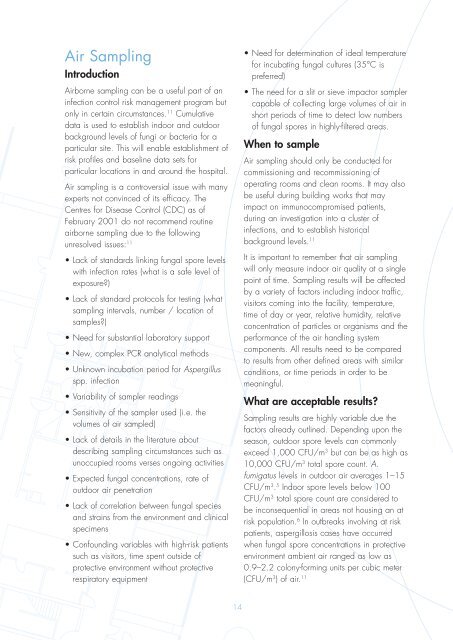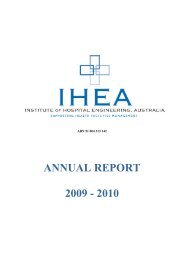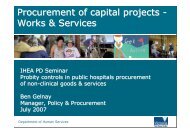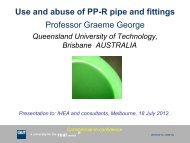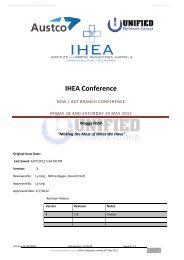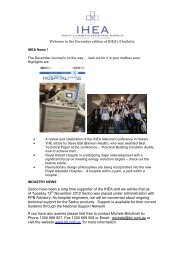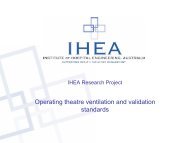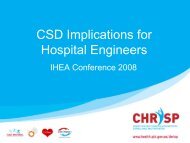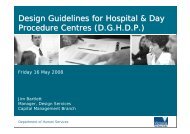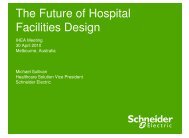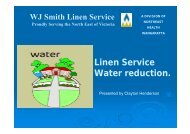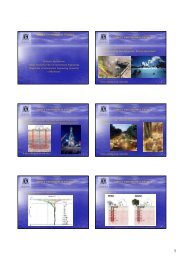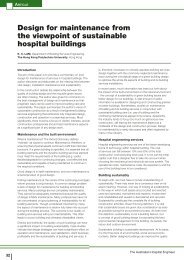Infection Control Principles for the Management of Construction ...
Infection Control Principles for the Management of Construction ...
Infection Control Principles for the Management of Construction ...
You also want an ePaper? Increase the reach of your titles
YUMPU automatically turns print PDFs into web optimized ePapers that Google loves.
Air Sampling<br />
Introduction<br />
Airborne sampling can be a useful part <strong>of</strong> an<br />
infection control risk management program but<br />
only in certain circumstances. 11 Cumulative<br />
data is used to establish indoor and outdoor<br />
background levels <strong>of</strong> fungi or bacteria <strong>for</strong> a<br />
particular site. This will enable establishment <strong>of</strong><br />
risk pr<strong>of</strong>iles and baseline data sets <strong>for</strong><br />
particular locations in and around <strong>the</strong> hospital.<br />
Air sampling is a controversial issue with many<br />
experts not convinced <strong>of</strong> its efficacy. The<br />
Centres <strong>for</strong> Disease <strong>Control</strong> (CDC) as <strong>of</strong><br />
February 2001 do not recommend routine<br />
airborne sampling due to <strong>the</strong> following<br />
unresolved issues: 11<br />
• Lack <strong>of</strong> standards linking fungal spore levels<br />
with infection rates (what is a safe level <strong>of</strong><br />
exposure?)<br />
• Lack <strong>of</strong> standard protocols <strong>for</strong> testing (what<br />
sampling intervals, number / location <strong>of</strong><br />
samples?)<br />
• Need <strong>for</strong> substantial laboratory support<br />
• New, complex PCR analytical methods<br />
• Unknown incubation period <strong>for</strong> Aspergillus<br />
spp. infection<br />
• Variability <strong>of</strong> sampler readings<br />
• Sensitivity <strong>of</strong> <strong>the</strong> sampler used (i.e. <strong>the</strong><br />
volumes <strong>of</strong> air sampled)<br />
• Lack <strong>of</strong> details in <strong>the</strong> literature about<br />
describing sampling circumstances such as<br />
unoccupied rooms verses ongoing activities<br />
• Expected fungal concentrations, rate <strong>of</strong><br />
outdoor air penetration<br />
• Lack <strong>of</strong> correlation between fungal species<br />
and strains from <strong>the</strong> environment and clinical<br />
specimens<br />
• Confounding variables with high-risk patients<br />
such as visitors, time spent outside <strong>of</strong><br />
protective environment without protective<br />
respiratory equipment<br />
• Need <strong>for</strong> determination <strong>of</strong> ideal temperature<br />
<strong>for</strong> incubating fungal cultures (35°C is<br />
preferred)<br />
• The need <strong>for</strong> a slit or sieve impactor sampler<br />
capable <strong>of</strong> collecting large volumes <strong>of</strong> air in<br />
short periods <strong>of</strong> time to detect low numbers<br />
<strong>of</strong> fungal spores in highly-filtered areas.<br />
When to sample<br />
Air sampling should only be conducted <strong>for</strong><br />
commissioning and recommissioning <strong>of</strong><br />
operating rooms and clean rooms. It may also<br />
be useful during building works that may<br />
impact on immunocompromised patients,<br />
during an investigation into a cluster <strong>of</strong><br />
infections, and to establish historical<br />
background levels. 11<br />
It is important to remember that air sampling<br />
will only measure indoor air quality at a single<br />
point <strong>of</strong> time. Sampling results will be affected<br />
by a variety <strong>of</strong> factors including indoor traffic,<br />
visitors coming into <strong>the</strong> facility, temperature,<br />
time <strong>of</strong> day or year, relative humidity, relative<br />
concentration <strong>of</strong> particles or organisms and <strong>the</strong><br />
per<strong>for</strong>mance <strong>of</strong> <strong>the</strong> air handling system<br />
components. All results need to be compared<br />
to results from o<strong>the</strong>r defined areas with similar<br />
conditions, or time periods in order to be<br />
meaningful.<br />
What are acceptable results?<br />
Sampling results are highly variable due <strong>the</strong><br />
factors already outlined. Depending upon <strong>the</strong><br />
season, outdoor spore levels can commonly<br />
exceed 1,000 CFU/m 3 but can be as high as<br />
10,000 CFU/m 3 total spore count. A.<br />
fumigatus levels in outdoor air averages 1–15<br />
CFU/m 3 . 5 Indoor spore levels below 100<br />
CFU/m 3 total spore count are considered to<br />
be inconsequential in areas not housing an at<br />
risk population. 6 In outbreaks involving at risk<br />
patients, aspergillosis cases have occurred<br />
when fungal spore concentrations in protective<br />
environment ambient air ranged as low as<br />
0.9–2.2 colony-<strong>for</strong>ming units per cubic meter<br />
(CFU/m 3 ) <strong>of</strong> air. 11<br />
14


